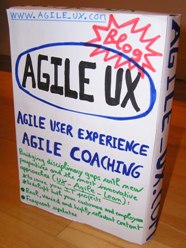Posted by jc-Qualitystreet on 2010/12/23
… Because their goal is to create the maximum value for the customer or prospect, as quickly and efficiently as possible;
… Because the Agile and Lean approach is the best way to deliver the right message at the right time to the right person.
Agile marketing is first the realization of IT projects for marketing using agile development… BUT it is also, from another perspective, the adoption of agile values, principles and practices beyond software in Marketing. And that is NEW!
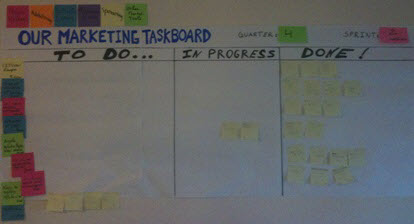
The agile marketing taskboard
After IT teams, this is now the marketing teams who want to become Agile. And some companies have even already taken the opportunity to adopt agility in their own business …
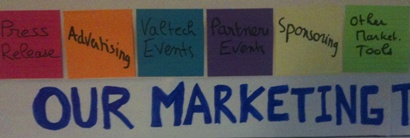
Agile Marketing Themes
The number of examples showing companies applying Agile & Lean practices beyond IT, such as in Communication, Training, Sales, or Marketing increases …
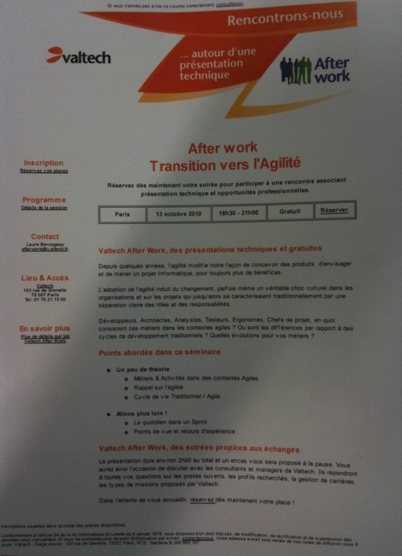
AfterworkAgile: An Agile marketing USER STORY
Via my French blog, I’ve heard about interesting projects outside the context of software development. In addition, my coaching activities enable me to work with Business people (often assigned to the role of Product Owner). Often, these inspiring and smart people quickly detect the potential benefits of Scrum or Kanban, in their daily activities.
See, adopt, adapt and replicate what really works!
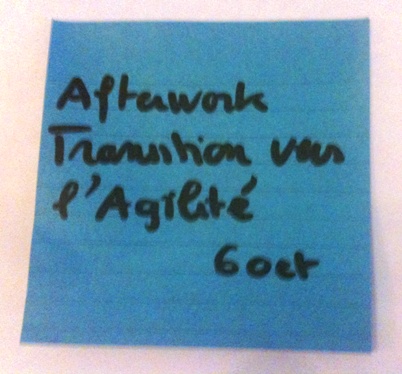
The same user story as a post-it placed in taskboard
The keys of Agile Marketing for marketing teams
- Adopt Agile planning with different levels of details and commitments:
- The Roadmap level (annual)
- The release Level (quarter)
- The Sprint level (with a duration of 3 weeks for Marketing Teams)
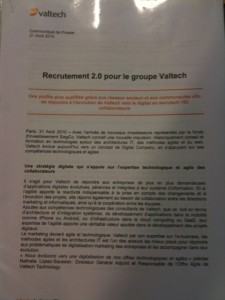
A Press Release User story (item of the sprint)
- Create a Taskboard to visualize and monitor the flow of activity (tasks) during the current Sprint

Taskboard - Quarter - Sprint
- Use visual Management (displaying the taskboard and important marketing tools for a better description, elicitation and understanding)
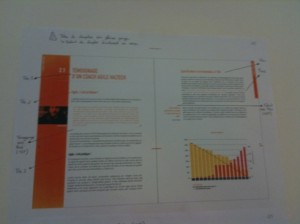
Visual management for marketing actions
- Use short cycles, called sprints. These short period of time (2 or 3 weeks) will also include Scrum ceremonials:
- Planning meeting: 1st day of the Sprint plan for all marketing activities for the next three weeks and the tasks to achieve it
- DailyScrum: Every day in the morning, no more than 10 minutes to synchronize, measure progress and identify impediments
- Sprint Review & Retrospective: Last day of Sprint, to inspect and adapt…
- Focus on Agile values (Courage, Communication, Feedback, Simplicity, Respect) for the team in its way of working together but also in its relations with internal and external partners….
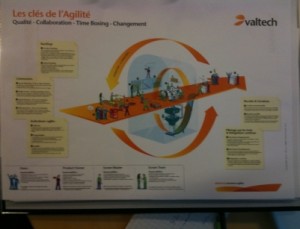
Keys to Agility... not only a User Story 🙂
- Use the user stories (categorized into themes and decomposed tasks that will be moved on the taskboard) for your marketing actions
- Gradually, calibrate your sprints by estimating your user stories, and at the end of each sprint, take the time for continuous reflection and improvement.
Posted by jc-Qualitystreet on 2010/12/21
Guess where in this very high building I gave my Scrum Product Owner training today 🙂
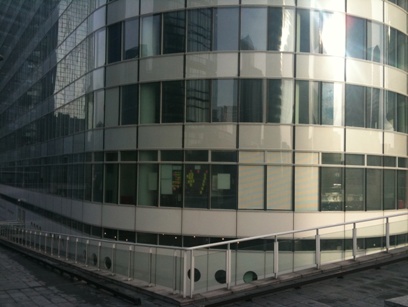
The answer:

And Inside ( only one side of the room !):

Being Agile it’s also being different in terms of environment !
Posted by jc-Qualitystreet on 2010/12/16
The Parking Lot helps to track important items, ideas and issues that may not be useful to discuss at a time in the agenda.
The principle is to return to them later.

Parking Lot in action
The Parking Lot is a simple facilitation tool: you just need a poster and some sticky notes. But it enables you to send strong messages to participants of a workshop:
1. « I’ve heard you »
2. « We won’t forget »
3. « We will talk about it for sure »
Indeed, at the end of the workshop or when the training day ends, we take 10 to 15 minutes to review the items put in the Parking lot with the team.
We seek to identify:
- Items that must be addressed now (AND so we do NOW)
- Items that need to be address but not right now (so they remain in the Parking Lot)
- Items that no longer need to be addressed, for example done (so we remove it…)
Because sometimes it is not the right time… For your training or coaching sessions, the Parking Lot is a really effective tool!
Posted by jc-Qualitystreet on 2010/12/10
First article dedicated to the responsibilities of the Agile manager, who has a major role to play in the agile adoption. At a time when the era of management 3.0 (a lean and agile management) is announced, the role manager is evolving, between opportunity and necessity
#1 Initiate and support communities of practice… which means
- Give time and resources to agile communities, ScrumMaster, Agile coaches, Product Owner, Agile Testers, Architects, UX Groups …,
- Give feedback on what is done by the communities of practice
- Promote agile communities of practice in the organization
- And why not participate and animate some communities (in a role of coordinator)
Communities of practice are an essential feature of the agile transformation programs we undertake. They are the perfect illustration of the « Yokoten » technique (the horizontal transfer of information and knowledge across the enterprise) used by Lean practionners.
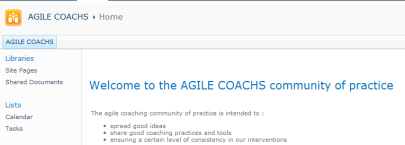
Agile coaching Community of Practice
What is a community of practice?
« Communities of practice are groups of people who share a concern or a passion for something they do and learn how to do it better as they interact regularly. » Etienne Wenger
The idea is not new, but makes sense now, at a time when companies are reconfiguring to become agile, and seek to increase the number of their dedicated, CROSS FUNCTIONAL and self-organized teams. Communities of practice are aligned to this purpose and enable to:
- Exchange on current practices
- Deepen knowledge and expertise
- Spread good ideas, practices and tools in the organization
- Bring together people across teams or product lines
- Coordinate and ensure the necessary consistency between the teams
Our community of practice is not a facebook like!
Its identity is built around the common interest for a specific DOMAIN and the willingness to learn. Passion, learning and commitment are the foundations of the community of practice. For example, I voluntarily belong to the « Agile Coaching » community of practice… because I am an agile coach, highly interested in the topic. But also because I want to contribute, share and discuss with other coaches (experienced or not). And, of course because I want to improve my own PRACTICES.
The same for the ScrumMaster… sometimes feeling alone, isolated within the team, he often needs to challenge himself and wants to discuss and share with the other ScrumMasters of the organization… The community of practice is primarily PRACTICES-ORIENTED, and focus on lessons learned, problems, solutions and vision. The community of practice is collective, dynamic, and collaborative. Members help each other and share information with a COMMUNITY mindset.
And the agile manager?
Communities of practice are not intended to appear in organizations chart. But even if they remain informal, they have a strong need for recognition and support.
Thus the role of the manager is crucial to face the five main challenges (organizational, managerial, community, personal and technical) related to the establishment of such communities in the company. Setting up new rules in the organization to facilitate the communities is often needed. The agile manager will also have to encourage and motivate people to participate, give feedback and handle the technical and logistics aspects to enable communities to express themselves online… and face to face. Because building a community of practice also requires solid relationships between the members, meeting physically and regularly is necessary. It has a cost and must be prepared. The openness of the community towards the outside of the company is also an important point of discussion with management.
At last, enabling the communities of practice to succeed and to flourish in the organization requires the recognition from HR and management of new collaborative skills among communities’ members. A community of practice is collective game.
For both the organization and the individual, the community of practice is the opportunity for knowledge capitalization and improvement. The communities of practice are highly valuable … and this is the responsibility of the agile management to support and develop them!
Posted by jc-Qualitystreet on 2010/12/05
But also a necessity!
The era of agile and lean management (see Management 3.0: Being an Agile Manager) is announced, and many factors contribute to the awareness and the birth of a sense of urgency that can serve as a starting point of willingness to change to lead middle managers to become agile managers.

The Agile Manager: Leadeship & Facilitation
The Enterprise environment
Fast, complex, competitive, changing, the external environment impacts the company itself. Pushed to review its governance, processes and valuable assets, the organization must also differentiate itself from its competitors in terms of knowledge, information sharing, skills and career management. The agile and lean enterprise is an obvious answer to these challenges, and middle managers, first line for these activities, have a major role to play. Whether supporting or opposing, they will be highly impacted by the fundamental changes introduced by an agile and lean approach.
The Rise of agility
Agile methods have spread into projects and in the everyday business life of people. Very popular in IT projects, agility is now everywhere and difficult to avoid. Managers can’t ignore it anymore. Moreover to understand what people actually do and how IT teams work, middle management will require the appropriate level of agile information and training… first steps toward change?
Concrete and visible results
It’s also difficult for middle management to ignore the benefits provided by Agile methods. Agility enables organization to reduce time to market, to improve product quality, to increase project visibility and productivity. Better team satisfaction and better end-user satisfaction are also observed. Agile methods have shown their efficiency and proved that it worked. Ten years after the Agile Manifesto, birth of Agility, agile and Lean practices continue to spread at a « unsustainable » pace 🙂 With the appropriate level efforts, an agile and lean approach gives fantastic results. So, why not applying some of these good practices and using them as a source of inspiration for management activities?
People expectations
Of course some needs and expectations of working people (achievement, recognition, empowerment…) are not new but the agile mindset is! An agile mindset grows within team members working with agile methods, and changes their relationship with others, with work and with their company. Collaboration, courage, feedback, simplicity and respect, the fundamental agile values are now also expected outside of the agile team, and primarly with middle management and hierarchy. Trust and feedback will be the keys.
From a generational point of view, the rapid growing of digital natives (people born after 1978) inside companies also changes the face of the enterprise and how the businesses operate. Digital natives need real time interactions & collaboration, networks, communities and a new management style. Once again, I have the feeling that agile management is a very good option to address the needs of this specific population.
HUMANITY, FACILITATION, COLLABORATION and LEADERSHIP seem to be the key characteristics of the AGILE MANAGER. And inspiration can be easily found in these few principles of lean management:
- Base your management decisions on a long term philosophy… even at the expense of short-term financial goals
- Grow leaders… who thoroughly understand the work, live the philosophy, and teach It to others)
- Develop exceptional people and teams… who follow your company’s philosophy
- Respect your partners and suppliers... by challenging them and helping them improve
- Go and see for yourself… to thoroughly understand the situation
- Make decisions slowly by consensus… thoroughly considering all options implement rapidly
- Become a learning organization... through relentless reflection (Hansei) and continuous improvement (Kaizen)















